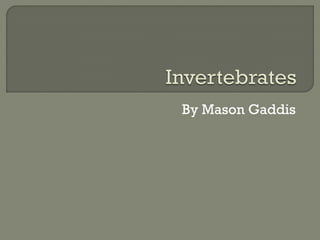
Invertebrates
- 2. The cobalt blue tarantula is a medium size tarantula with a leg span of approximately 13 cm. It is noted for its iridescent blue legs and light gray thorax. It inhabits the tropical rain forests of southeast Asia. Here they construct deep burrows, and generally only leave them to find food.
- 3. The blue-ringed octopus is an octopus species that lives in tide pools in the Pacific Ocean, from Japan to Australia. They are currently recognized as one of the world's most venomous marine animals. Despite their small size and relatively docile nature, they can prove a danger to humans. They can be recognized by their characteristic blue and black rings and yellowish skin.
- 4. Striking yellow, with aggregated black spots and white spiracles surrounded by black. Transformation of the larva into the adult begins with the attachment of strong, silken threads onto adjacent leaves. Over a couple of days, bodily contractions and fluid secretions progress to complete pupation. Some seventeen days later, the moth emerges on the afternoon, with its heavy, stout, bright-yellow body and royal- blue wings with numerous translucent windows.
- 5. Gets its name because they appear in both rural and urban areas around Christmas in Australia. Christmas Beetle females lay eggs in soil in the spring and early summer. The Larvae live in the soil, and feed on decaying organic matter or roots. Adult beetles emerge during the early to mid summer period from soil.
- 6. Blue Tiger Butterflies have pale blue patterns with a black background on their wings. The Blue Tiger Caterpillar feeds on several different vines. Their pupa is fresh green and shiny with some golden spots. You can tell the age of a butterfly by its wing edges and color. If they are faded, then it is older.
- 7. Sponges are colonies of thousands of individual cells. The cells work together, pumping water through the body of the sponge. The tall tube is in the shape of a "chimney." This chimney is an exhaust tube, where the water pumped by the sponge comes out. The sponge eats the plankton it filters out of the water as the water is pumped through the body of the sponge.
- 8. Nematocysts (stinging cells) found in the tentacles assist the anemone to catch and paralyze prey. After feeding and digestion is complete, the anemone excretes its waste back through the mouth opening. It feeds on sea urchins, small fish, and crabs, but detached mussels are the main food source.
- 9. The largest recorded specimen found, had a bell (body) with a diameter of 7 feet 6 inches and tentacles 120 feet long. They remain mostly very near the surface, their slow pulsations weakly driving them forwards; they depend on ocean currents whereby the jellies travel great distances. The jellyfish are most often spotted during the late summer and autumn, when they have grown to a large size and the currents begin to sweep them closer to shore.
- 10. They have five short arms and thousands of small sucker feet on their underside. When hungry, the cushion starfish pushes its stomach out of its body through its mouth to surround food. They are scavengers that feed on dead plants and animals.
- 11. It has the largest leg span of any arthropod, reaching up to 12 ft. and weighing up to 41 pounds. They are mostly found off the southern coasts of the Japanese island of Honshū. It feeds on shellfish and animal carcasses and may live for up to 100 years.
- 12. Praying mantis are highly predacious and feed on a variety of insects, including moths, crickets, grasshoppers and flies. They lie in wait with the front legs in an upraised position. They also will eat each other. The Praying mantis is often protectively colored to the plants they live on, camouflaging them from predators.
- 13. They have no body cavity, and no specialized circulatory and respiratory organs, which restricts them to flattened shapes that allow oxygen and nutrients to pass through their bodies by diffusion. Most are predators or scavengers, and terrestrial species are mostly nocturnal and live in shaded humid locations such as leaf litter or rotting wood.
- 14. Tapeworms have no mouths or guts, and the syncytial skin absorbs nutrients – mainly carbohydrates and amino acids – from the host, and also disguises it chemically to avoid attacks by the host's immune system.
- 15. The majority of leeches live in freshwater environments, while some species can be found in terrestrial and marine environments. Most leeches are hematophagous, which means they are predominantly blood suckers that feed on blood from vertebrate and invertebrate animals.